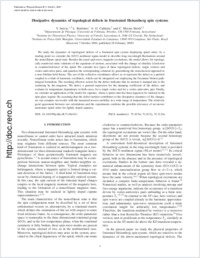Dissipative dynamics of topological defects in frustrated Heisenberg spin systems
Université de Fribourg
- Juricic, Vladimir Department of Physics, University of Fribourg, Switzerland - Institute for Theoretical Physics, University of Utrecht, The Netherlands
- Benfatto, Larra Department of Physics, University of Fribourg, Switzerland
- Caldeira, A. O. Instituto de Física Gleb Wataghin, Universidade Estadual de Campinas, São Paulo, Brazil
- Morais Smith, Cristiane de Department of Physics, University of Fribourg, Switzerland - Institute for Theoretical Physics, University of Utrecht, The Netherlands
-
28.02.2005
Published in:
- Physical Review B. - 2005, vol. 71, no. 6, p. 064421
English
We study the dynamics of topological defects of a frustrated spin system displaying spiral order. As a starting point we consider the SO(3) nonlinear sigma model to describe long-wavelength fluctuations around the noncollinear spiral state. Besides the usual spin-wave magnetic excitations, the model allows for topologically nontrivial static solutions of the equations of motion, associated with the change of chirality (clockwise or counterclockwise) of the spiral. We consider two types of these topological defects, single vortices and vortex-antivortex pairs, and quantize the corresponding solutions by generalizing the semiclassical approach to a non-Abelian field theory. The use of the collective coordinates allows us to represent the defect as a particle coupled to a bath of harmonic oscillators, which can be integrated out employing the Feynman-Vernon path-integral formalism. The resulting effective action for the defect indicates that its motion is damped due to the scattering by the magnons. We derive a general expression for the damping coefficient of the defect, and evaluate its temperature dependence in both cases, for a single vortex and for a vortex-antivortex pair. Finally, we consider an application of the model for cuprates, where a spiral state has been argued to be realized in the spin-glass regime. By assuming that the defect motion contributes to the dissipative dynamics of the charges, we can compare our results with the measured inverse mobility in a wide range of temperature. The relatively good agreement between our calculations and the experiments confirms the possible relevance of an incommensurate spiral order for lightly doped cuprates.
- Faculty
- Faculté des sciences et de médecine
- Department
- Département de Physique
- Language
-
- English
- Classification
- Physics
- License
-
License undefined
- Identifiers
-
- RERO DOC 5299
- DOI 10.1103/PhysRevB.71.064421
- Persistent URL
- https://folia.unifr.ch/global/documents/299895
Statistics
Document views: 220
File downloads:
- Texte intégral: 229
